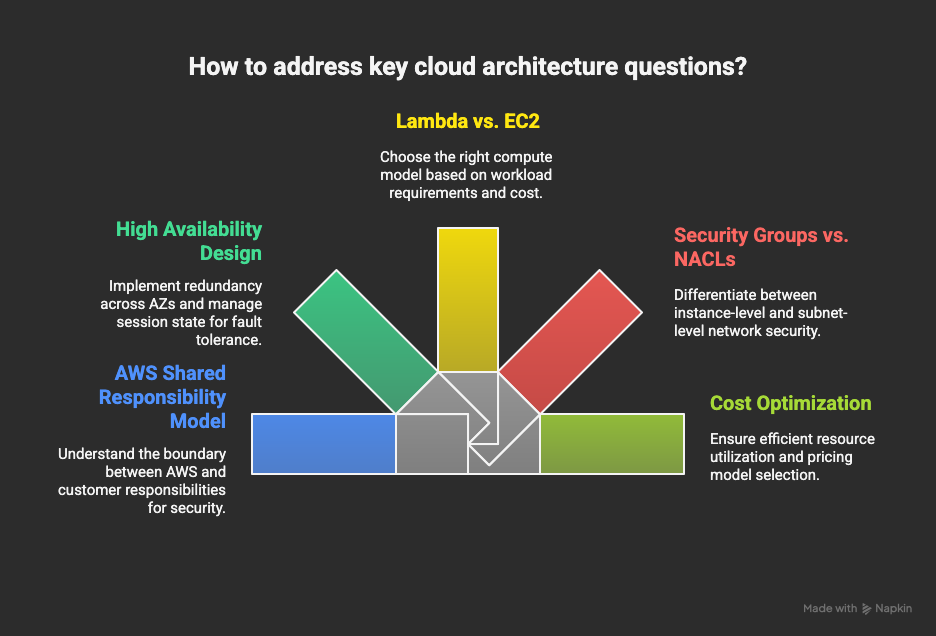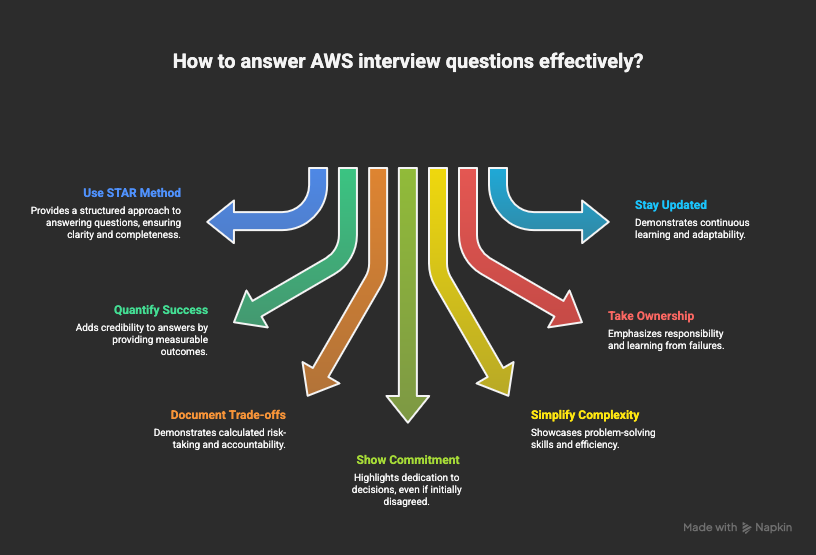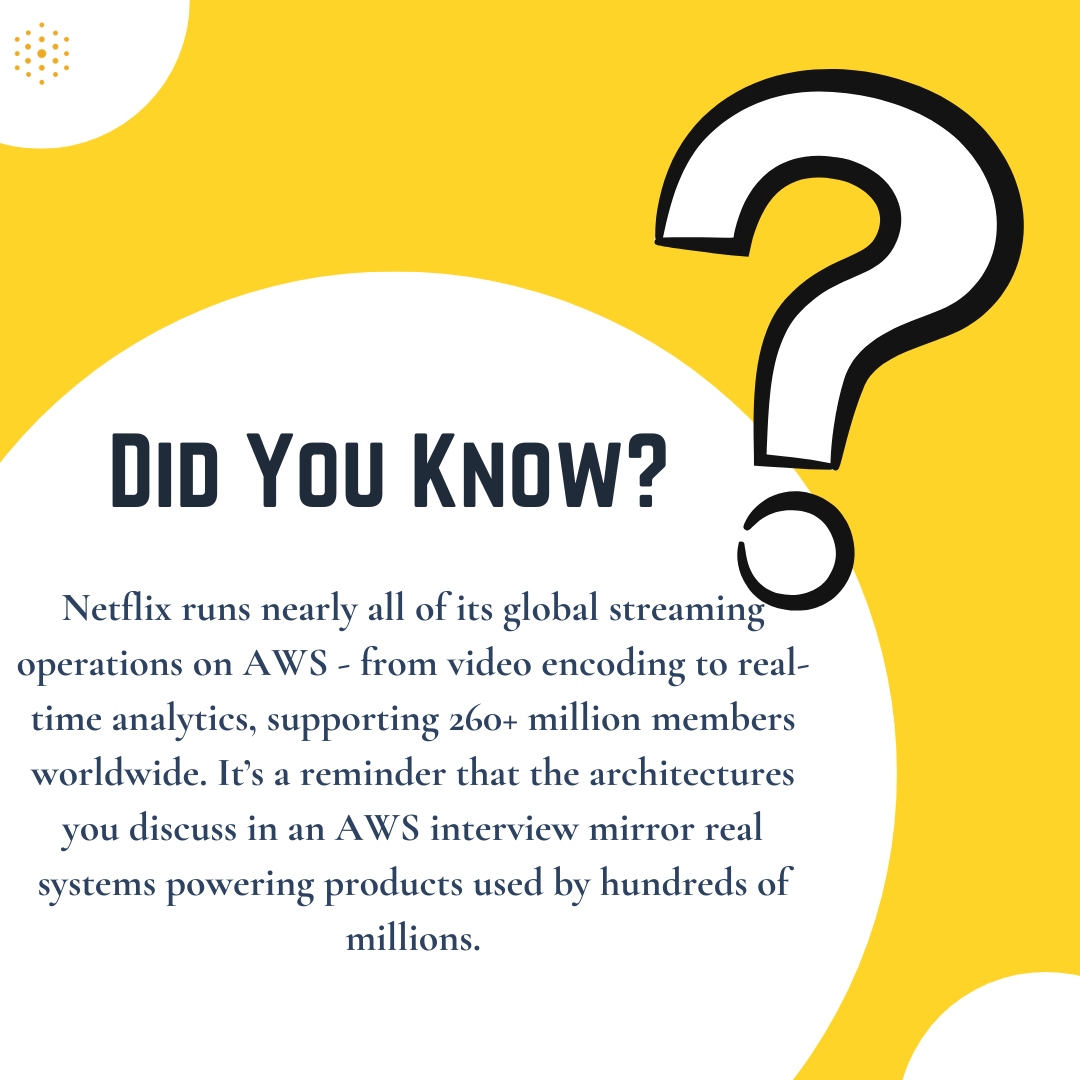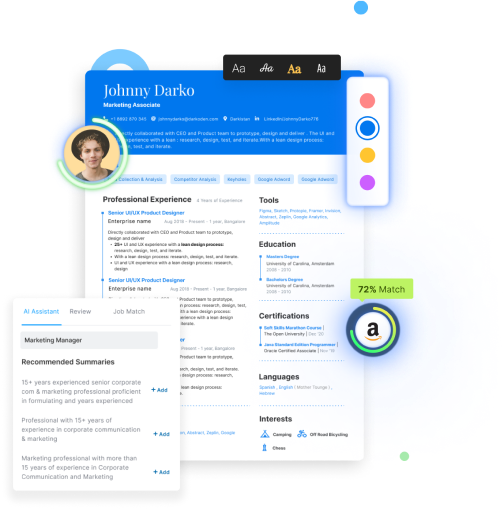The cloud job market continues to accelerate as companies double down on scalable, cost-efficient, and secure infrastructure - making AWS one of the most in-demand technical skill sets today.
According to Gartner, global spending on public cloud services is forecast to total $723.4 billion in 2025, up from $595.7 billion in 2024, underscoring how quickly organizations are adopting cloud-first architectures.
But in a competitive market, knowing AWS isn’t enough.
Standing out in an interview requires strong preparation, the ability to think architecturally, and clear alignment with Amazon’s Leadership Principles.
Below are 10 AWS interview questions with sample answers that consistently signal high-caliber talent, along with practical guidance on how to answer them with confidence.
The Technical & Architectural Deep Dives
These questions test your understanding of core services, cost, and security - the three pillars that drive most cloud business decisions.
1. Explain the AWS Shared Responsibility Model
This is the foundation of cloud security. Recruiters want to know you understand the boundary between AWS's job ("Security of the Cloud") and the customer's job ("Security in the Cloud").
A failure here indicates a high risk of misconfigurations and security breaches.
How to Answer: Don't just list the separation; provide an example. Use the analogy of a rented apartment. Detail how your responsibility shifts depending on the service model (IaaS, PaaS, SaaS).
Mention that management plane security (IAM, Regions, AZs) is always AWS's, but OS patching and data encryption are always yours.
Sample Answer: "The Shared Responsibility Model clearly defines that AWS is responsible for the Security of the Cloud, meaning the infrastructure like compute, storage, networking, and the physical security of data centers. I am responsible for the Security in the Cloud. For an EC2 instance, I manage the OS patching, network configuration via Security Groups, and data encryption. If I use S3, AWS handles durability (S3 is designed for 99.999999999% durability), but I control access policies (IAM) and data encryption. This is vital for maintaining compliance."
Also Read: How to make a job winning AWS resume?
2. How would you design a highly available and fault-tolerant web application?
This is a core architectural design question. It tests if you understand the concept of redundancy across multiple failure domains (Availability Zones or AZs) and how to manage session state.
How to Answer: Structure your answer using layers. Always start with multiple AZs. Use specific AWS services to solve specific problems (e.g., Route 53, ELB, Auto Scaling, Multi-AZ RDS).
Crucially, explain how you handle session data (e.g., using ElastiCache or DynamoDB instead of local instance storage).
Sample Answer: "I would use Amazon Route 53 with a failover routing policy and an Application Load Balancer (ALB) distributing traffic across two or more Availability Zones in a region. The back-end would use an Auto Scaling Group (ASG) to scale EC2 instances horizontally, ensuring we can handle demand spikes and instance failure. We would decouple static content onto Amazon S3 and run the relational database using RDS Multi-AZ for synchronous replication. Any required session state would live in ElastiCache (Redis) to prevent session loss if an EC2 instance terminates."

3. When should you use AWS Lambda instead of Amazon EC2?
This question tests your ability to choose the right compute model (Serverless vs. IaaS) and understand the trade-offs of cost, operational overhead, and control (a key aspect of the LP Frugality).
How to Answer: Focus on the operational model and cost savings. Lambda eliminates server management and scales automatically to zero. Mention that Lambda is ideal for event-driven, intermittent, or asynchronous workloads.
EC2 is better for long-running processes, complex operating system needs, or legacy applications.
Sample Answer: "I choose Lambda when I need to execute code that is event-driven or requires minimal operational overhead. Lambda manages the servers, patching, and scaling, supporting the LP of Frugality by only charging for compute time used. I reserve EC2 for steady-state applications, applications with specific OS or hardware requirements (e.g., GPU), or processes that require consistent, long-running background tasks. Lambda is perfect for handling image resizing after an S3 upload, whereas EC2 is needed for a traditional, 24/7 web server."
Also Read: What is a cloud engineer?
4. Differentiate between Security Groups and Network Access Control Lists (NACLs).
This checks your grasp of layered network security within a Virtual Private Cloud (VPC). It ensures you know how to secure a network at the instance versus the subnet level.
How to Answer: Define the key differences - Stateful vs. Stateless and Applies to Instance vs. Applies to Subnet and explain how NACLs work with deny rules, and how Security Groups only use allow rules.
Sample Answer: "A Security Group (SG) is a stateful, instance-level firewall. It permits all outbound traffic by default, and any inbound connection allowed is automatically allowed for the return outbound traffic. A NACL is a stateless, subnet-level firewall. It applies to all instances within the subnet and requires separate rules for both inbound and outbound traffic. Crucially, NACLs have an explicit DENY rule capability, whereas Security Groups only have ALLOW rules. NACLs are primarily a coarser, last line of defense for a subnet's boundaries."
5. How do you ensure cost optimization in your AWS environment?
This question directly assesses the Frugality Leadership Principle. Cloud costs can spiral, and recruiters prioritize candidates who treat infrastructure as a financial responsibility. Over 54% of cloud waste stems from a lack of cost visibility.
How to Answer: Focus on proactive cost management, not just using Reserved Instances. Mention monitoring, identifying unused resources, and using the right pricing model for the workload.
Sample Answer: "My approach is proactive and multi-layered, aligning with Frugality. First, I use AWS Cost Explorer and Budgets to gain visibility. I consistently terminate unused or orphaned resources like EBS volumes and unattached Elastic IPs. I ensure applications use the most cost-effective architecture, prioritizing Serverless (Lambda, DynamoDB) over IaaS when possible. For stable workloads, I leverage Savings Plans or Reserved Instances, aiming to cover the predictable 70-80% of our usage baseline. Finally, I monitor S3 data tiers to ensure infrequently accessed data moves to S3-IA or Glacier."
Also Read: How much do cloud engineers earn?
The Behavioral & Strategic Principles
AWS interviews often dedicate the majority of time to behavioral questions, assessing your alignment with the 16 Amazon Leadership Principles.
Always answer using the STAR Method (Situation, Task, Action, Result) and use metrics to quantify your success.
6. Tell me about a time you had to deal with a technical decision that required significant trade-offs
Why Recruiters Ask: This tests Bias for Action and Deliver Results. They want to see if you can make a calculated risk, manage a project under pressure, and understand that some reversible decisions don't need extensive study.
How to Answer: Frame the conflict clearly. Detail the metrics you used to make the decision. Emphasize that you documented the trade-off and had a rollback plan, demonstrating a calculated risk rather than recklessness.
Sample Answer:
"Situation: We had a critical feature release blocked by a buggy internal dependency, risking a missed public deadline. Task: I needed to decide whether to wait for the dependency fix (delaying launch by three days) or implement a temporary mock service using a simple Lambda/DynamoDB endpoint for the initial launch. Action: I initiated a one-hour meeting with the engineering and product leads. We decided to take the action of building the mock service, minimizing the scope to just the necessary data points, and scheduling a full deployment rollback upon successful launch validation. Result: We met the deadline, launching the feature on time. The mock service handled 99.9% of the expected initial load. The permanent fix was deployed two days later, and we reduced the overall project risk by 40% because we had a successful, on-time launch."
7. Describe a situation where you had to challenge a manager or senior stakeholder on a technical decision
Why Recruiters Ask: This LP is about courage and conviction. Recruiters want evidence that you will speak up if you foresee a flaw in a design, but still commit to the final decision.
How to Answer: State the facts and the risk. Show that your challenge was based on data or technical constraints, not just opinion. Always end by stating that once the final decision was made, you fully committed to executing it, regardless of your initial stance.
Sample Answer:
"Situation: My manager mandated migrating our data warehouse to a specific Redshift instance type because it was cheaper on a Reserved Instance (RI). Task: I knew this instance type lacked the required IOPS for our nightly ETL process, which would jeopardize the data freshness SLA. Action: I gathered performance data from the current system and presented a side-by-side comparison in terms of dollars-per-IOPS, showing that the slightly more expensive instance type would cost an extra $10,000 annually but would save the data engineering team 40 man-hours per month in troubleshooting. Result: The manager ultimately agreed, realizing the long-term operational cost outweighed the short-term RI saving, demonstrating long-term value over short-term gain (Ownership LP). I then led the migration process, ensuring a smooth transition."

8. How did you simplify a complex system or process?
Why Recruiters Ask: This tests your ability to cut through complexity and find elegant solutions, often using AWS managed services to replace complex self-managed infrastructure.
How to Answer: Define the complexity first. Use metrics to show the time/cost savings from the simplification. Focus on removing unnecessary steps or layers.
Sample Answer:
"Situation: Our deployment process relied on a self-managed Jenkins server running on an EC2 instance, which often failed during updates and required manual maintenance. Task: My goal was to simplify the CI/CD pipeline to reduce maintenance overhead and increase deployment success rate. Action: I proposed migrating the entire pipeline to a fully managed Serverless solution using AWS CodePipeline and CodeBuild. This eliminated the need to manage any infrastructure, patching, or scaling for the build environment. Result: The new process reduced the average deployment time by 60% and eliminated the monthly server patching window, saving the team an estimated 8 hours of maintenance per month."
Also Read: How to ace your first job interview?
9. Tell me about a time you failed to deliver on a critical project or made a wrong technical decision.
Why Recruiters Ask: Amazon values candidates who are vocally self-critical and constantly seeking to improve. They want to see maturity and a structured path to prevent recurrence.
How to Answer: Take full ownership of the failure (Ownership LP). Detail the measurable negative result, but spend the majority of the answer on the learning and the mechanism you put in place to ensure the mistake stays fixed (Insist on the Highest Standards LP).
Sample Answer:
"Situation: I underestimated the bandwidth requirements for migrating a large dataset (50TB) over a VPN connection to AWS, causing our initial cutover window to fail midway through. Task: We needed to ensure the migration was successful and that we learned from this miscalculation. Action: I immediately initiated a root cause analysis, confirmed the VPN limitation, and quickly pivoted the strategy. I successfully advocated for using an AWS Snowball Edge device for the remainder of the data, which was much faster. I also instituted a mandatory ‘pre-migration checklist’ for all future transfers that includes a calculated bandwidth-per-TB time estimate. Result: The Snowball transfer completed on time. The new checklist has since been used for three other projects and has reduced pre-migration risk assessment time by 75%."
10. How do you stay updated on new AWS services and features? (Learn and Be Curious)
Why Recruiters Ask: This tests your initiative, passion, and commitment to the Learn and Be Curious LP. The AWS ecosystem is vast and changes rapidly, so self-development is non-negotiable.
How to Answer: Provide specific, actionable examples. Mention the high-quality, official resources you use and explain how you apply the learning in a low-risk environment.
Sample Answer:
"I actively track the AWS Blog and What’s New page daily. I also commit time weekly to AWS Skill Builder for formal training. When a new service is released (like a new database offering or a new EC2 instance family), I test it immediately using the AWS Free Tier in a scratch sandbox account to understand its core features and pricing structure. For instance, I recently investigated how to optimize our database costs by exploring Aurora Serverless v2 over our existing provisioned Aurora cluster, which provided a 40% reduction in idle costs during non-peak hours."

Wrapping Up
Success in AWS interviews often comes down to how well you translate concepts into clear, real-world reasoning.
The candidates who stand out are the ones who’ve sharpened their thinking through deliberate practice and can articulate why they’d choose a specific design, not just what AWS service fits the use case.
If you want a more structured way to prepare, Hiration can help you sharpen both your technical and behavioral responses.
You can generate tailored interview questions by pasting any job description, get real-time feedback on structure and clarity, and even refine speech, tone, posture, and eye contact through detailed video analysis.
You can record, review, and continually improve your answers as you practice.
And when you're ready to apply, you can polish your entire application with Hiration’s resume and cover letter builder, and LinkedIn profile optimizer - everything you need to present your best self in one place.



